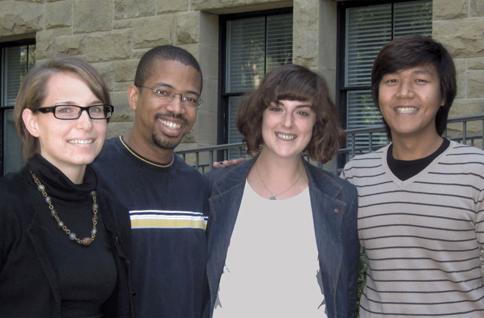If your neighbor is robbed on her doorstep just before dawn, do you wait for sunrise to leave your own home? Women in Mathare, the second-largest slum in Nairobi, don’t have the luxury of waiting. Many are the sole income provider for several children, and risk their physical and financial safety to work long hours in the city center. In a world where the police don’t answer emergency calls and thieves are a dime-a-dozen, women have little to protect themselves on the long walk to central Nairobi.
I spent spring break investigating the community needs of Mathare, walking through the neighborhood and listening to the stories of residents in order to better understand the community’s needs. Needs are in no short supply, and chaos only begins to describe this vast informal settlement. Mathare is the smaller of the two largest slums (Kibera is the largest), where tens of thousands cram under tinny roofs on the hillside of a polluted river. “Kibera is a beautiful young woman—Mathare is an old lady with three children,” one Kenyan offered in explanation. Kibera receives significant aid attention (both from the Kenyan government and internationally), while Mathare is the stronghold of powerful militias and gangs.1
We first approached the problem of security by looking at maps. Three days after I flew back from Kenya, we formed teams in the Designing Liberation Technologies course in the Stanford d.school. We searched maps for the locations of problem areas, where women travel to and from, and where the police were likely to respond to crime. But no one could tell us where the problem areas were, only that they existed. Without house numbers and street names, residents of Mathare orient to landmarks and don’t use maps. I started feeling like we were running in circles, like the problem was always around the next corner, unwilling to show its face.
Without the physical location of the problem, we began asking temporal questions. We heard a unanimous story: the darker the hour of the day, the greater the danger. Our classmates brainstormed security-related solutions with us. First, we thought of the lighting problem: if the darker hours were more dangerous, why not light them? But Mathare already had 40-foot light poles in several neighborhoods.2
Are you enjoying this article? Read more like this, plus SSIR's full archive of content, when you subscribe.
Next we tried to frame the problem in terms of community cohesion and responsibility. Couldn’t we model a solution after the Neighborhood Watch Program? If we designated recognizable landmarks as safe points and stationed trusted volunteers, would women gravitate toward them? We tested this scenario in the d.school, enlisting one professor as a villain and a classmate as a commuting woman. Though the scenario was not true to life, it revealed several design-shattering problems: The attacker was undeterred by having witnesses surrounding him at the safe point, the volunteers couldn’t reach the location quickly enough, and the woman felt like a sitting duck.
There were further problems that we uncovered in interviewing residents of Mathare. Because the safe points were publicized, criminals and thieves would know where to find women who felt insecure. We were essentially broadcasting the location of potential targets. “It’s a great idea,” the professors encouraged us, “but it needs more work.”
Women needed a way to feel secure while traveling, but had no recourse if attacked. People in Mathare joke that you can spend your whole life waiting for police assistance—and people in Mathare don’t ever ask for help.3 Could we foster security without providing recourse?
After seven weeks of work, we reached a revelation. Women would sometimes organize their own walking groups, but it was costly (to communicate via SMS with a large number of people) and difficult. What if we provided the organization and eliminated the cost? Our solution was a bus system that lacks a bus. Makmende4 is an escort system that provides women with coordinated walking groups during dawn and dusk hours. Escorts walk along regular routes, traversing the most heavily trafficked and dangerous areas of Mathare. Women can send an SMS or call the Makmende hotline for the schedule and locations of escort groups, helping them spend less time outside the home and more time with trusted community members. Makmende allows a woman to leverage the power of numbers to increase her safety along her commute, empowering her to walk freely.

This is the first in an ongoing series of posts on the Makmende Community Security Initiative. The series is intended to present the initiative as a “living case study.” In the next post, the Makmende team will cover of their return to Nairobi in July, when they connected with sponsor organizations and administered a baseline survey.
Notes
1 Gangs constitute a layer of civil society that can often furnish more public services than the Kenyan government itself—making them feared but somewhat welcome entities in a neighborhood like Mathare.
2 The hurdles impeding development are primarily infrastructural. In Mathare, these lights are on at night—but only when there’s electricity.
3 The reasons for this are varied and often deeply personal, but people in Mathare tend to ask for help only in life-or-death situations. There aren’t doctors, firemen, or police in Mathare, so in situations requiring such expertise most people have to fend for themselves.
4 “Makmende” is a Kenyan superhero meme—the image of dashing, righteous, retro revenge, the ultimate hero. (Derived from “make my day” and well-depicted on YouTube). But he’s just the shadow of a dream, an instance of Kenyans optimism that they never quite find (see Ethan Zuckerman). He’s a fitting patron saint for the sustenance of community security.
Support SSIR’s coverage of cross-sector solutions to global challenges.
Help us further the reach of innovative ideas. Donate today.
Read more stories by Clare Corthell Bennett.

